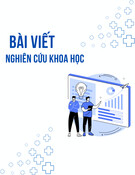
http://www.iaeme.com/IJM/index.asp 303 editor@iaeme.com
International Journal of Management (IJM)
Volume 7, Issue 7, November–December 2016, pp.303–312, Article ID: IJM_07_07_034
Available online at
http://www.iaeme.com/ijm/issues.asp?JType=IJM&VType=7&IType=7
Journal Impact Factor (2016): 8.1920 (Calculated by GISI) www.jifactor.com
ISSN Print: 0976-6502 and ISSN Online: 0976-6510
© IAEME Publication
ROLE OF EVENT ORGANISING COMPANIES IN
INCREASING THE BRAND IMAGE OF THE CLIENT
COMPANIES
Dr. S. Hemanthkumar
Associate Professor, M P Birla Institute of Management, Bangalore, India
B.V Pushpa
Assistant Professor, M P Birla Institute of Management, Bangalore, India
ABSTRACT
Event organising is growing at a rate of three times that of traditional advertising. Though
relatively small compared to the major components of the marketing communications mix
advertising, sales promotions and P-O-P communications-expenditures on event sponsorship are
increasing. Corporate sponsorships are offered to various events ranging from sports to festivals to
fairs. Thousands of companies invest in some form of event sponsorship. Event organising is a
form of brand promotion that ties a brand to a meaningful athletic, entertainment, cultural, social
or other type of high-interest public activity. Event organizing is distinct from advertising, sales
promotion, point-of-purchase merchandising, or public relations, but it generally incorporates
elements from all of these promotional tools. Event promotions have an opportunity to achieve
success because, unlike other forms of marketing communications, events reach people when they
are receptive to marketing messages and capture people in a relaxed atmosphere. Event organising
is growing rapidly because it provides companies alternatives to the cluttered mass media, ability
to segment on a local or regional basis, and opportunities for reaching narrow lifestyle groups
whose consumption behaviour can be linked with the local event. The need for the study is to
analyse certain issues in events organizing and event management, which need further attention.
The study uses SPSS for statistical analysis, cross tabulation and chi square for analysing data
obtained from structured questionnaire. The study concludes that factors such as quality of service,
employee engagement and relationship, use of updated technology, customisation and attracting
clients through advertisement and publicity are important factors that determine brand identity of
the event management companies.
Key words: Brand Identity, Event management, quality of service, chi square analysis.
Cite this Article: Dr. S. Hemanthkumar and B.V. Pushpa, Role of Event Organising Companies in
Increasing the Brand Image of the Client Companies. International Journal of Management, 7(7),
2016, pp. 303–312. http://www.iaeme.com/IJM/issues.asp?JType=IJM&VType=7&IType=7

Dr. S. Hemanthkumar and B.V. Pushpa
http://www.iaeme.com/IJM/index.asp 304 editor@iaeme.com
1. INTRODUCTION
Event showcasing is developing at a rate of three times that of customary publicizing. Event showcasing is
a type of brand advancement that binds a brand to an important athletic, stimulation, social, social or other
kind of high-intrigue open movement. Events along with corporate sponsorship help in showcasing and
publicizing, deals etc. Event management for the most part means conceptualizing, fastidious arranging,
sorting out lastly executing an occasion or events. It is a set arrangement including systems administration
of a mixed media bundle, in this manner accomplishing the customer’s destinations and advocating their
requirements for taking up with occasions. The event management and showcasing industry is growing at a
rate of 17 Percent for every year, and they have accomplished an abnormal state of achievement.
Marketing professionals use this as a valuable tool to connect to their existing and potential customers. In
the growing era of globalisation, event management professionals are coming out with new ways to engage
their customers through trade shows, live events etc. Generating leads and nurturing new customers is
becoming the main areas of focus now. Events ranging from formal conferences, brand promotion to
corporate parties to music concerts, fashion, sports, high profile weddings and entertainment parties come
under the purview of event management companies now. Whole process happens in various stages from
preliminary discussions, prefinal talks to articulation and arrangement of stages, visuals, logistics etc.
Events help in brand building, creating awareness about the launch or new products or brand and
helping in restoring brands during the distinctive phases of item life cycle, repositioning of brands,
associating the brand identify of customers with the identity of target business sector, implementation of
marketing plan etc.
2. LITERATURE REVIEW
Rashid Saeed (2013) this study aims to check the impact of brand picture on brand faithfulness and the
directing part of consumer loyalty in the remote telecom division of Pakistan. The study focused on brand
properties and brand advantages by surveying around 150 sample respondents who were mainly students
and educators from various schools and colleges of Sahiwal. The results obtained from regression and
correlation analysis revealed that a positive and noteworthy connection exists between brand picture, brand
steadfastness and consumer loyalty. In addition, associations pay more to assemble unique thoughtfulness
regarding manufacture the brand picture and to accomplish consumer loyalty.
Baseer Ali Durrani (2015) this study was intended to explain the effect of brand picture on teenager’s
brand decision and various elements influencing purchasing decision and level of fulfilment from around
300 respondents. The regression results conclude that 33% of the purchase decision and conduct is
dependent on commercials, brand picture, promotional tools used by the company. The Pearson
relationship demonstrates that adolescents purchasing conduct is fundamentally 36% associated with
young people reliability and 49% with notice sway on brand picture. This paper recommends that
organizations dealing with products meant for youngsters should focus more on notices, and promotions.
Huseyin Kose (2011) this paper tells that the point of the study was to see the measurements of event
administration and event advertising. The investigation of the information was utilized by contextual
analysis. They used both essential and optional data (observations, internet, resources, press& visual
media). This paper concentrates on the measurements of occasion administration named ticketing,
transportation, HR (volunteers and prepared staff) planning, advertising and PR and danger administration.
By and large the study finds that the most critical thing is to oversee hazard administration measurement
where administrators ought to do chance administration well by occasion ambulances, medicinal groups
and security staff constantly prepared.
Fransisca Andreani (2012) this paper advises that the fundamental target is to look at the effect of
brand picture towards client devotion with consumer loyalty as a go between. The study used Partial Least
Square (PLS) and results demonstrate that there is a positive effect of quality of brand affiliation towards
client steadfastness, consumer loyalty and consumer loyalty towards client faithfulness.

Role of Event Organising Companies in Increasing the Brand Image of the Client Companies
http://www.iaeme.com/IJM/index.asp 305 editor@iaeme.com
3. RESEARCH DESIGN
3.1. Statement of the Problem
Event organizers plays a vital role in creating & improving the brand image of the companies where in few
organizers are not producing the quality of the brand that is necessary for the company & it does not add
any value by that event so now a day’s corporate clients are very much curious of selecting the event
organizers who are very good & they view that it adds value & maintain the standards of creating the brand
image of the company by organizing the event successfully. Hence this study is taken up in order to know
the role of event management companies in boosting the brand image of client companies.
3.2. Objectives of the Study
• To understand the concepts of event organizing its benefits & implementation process in various events of
different companies
• To evaluate the effectiveness of event organizing as a promotional tool to the company brand image
• To offer suggestions for improvement to make it a more productive investment for the company by
organising the event this adds value & benefits of the company.
3.3. Hypothesis
H0: Price of successful events and Brand Identity of successful events are independent of each other.
H1: Price of successful events and Brand Identity of successful events are dependent of each
Other
H0: Employee relations of successful events and Brand Identity of successful events are independent of
each other.
H1: Employee relations of successful events and Brand Identity of successful events are dependent of each
other
H0: Unique of successful events and Attracting customers of successful events are independent of each
other.
H1: Unique of successful events and Attracting customers of successful events are dependent of each other
H0: Employee relations of successful events and Attracting customers of successful events are
independent of each other.
H1: Employee relations of successful events and Attracting customers of successful events are dependent
of each other
H0: Technology building brand and event organising companies benefited to clients are independent of
each other
H1: Technology building brand and event organising companies benefited to clients are dependent of each
other
H0: Publicity building brand and event organising companies benefited to clients are independent of each
other
H1: Publicity building brand and event organising companies benefited to clients are dependent of each
other
3.4. Sampling
The study will be restricted to Bangalore city. The sample size consists of 60 respondents involving
employees and corporate clients. Convenient sampling method has been used for this research.

Dr. S. Hemanthkumar and B.V. Pushpa
http://www.iaeme.com/IJM/index.asp 306 editor@iaeme.com
3.5. Sources of Data
The data for the study was obtained from detailed discussions with event management firms and the
corporate clients. Subsequent additions were made to the interview schedule to suit the specific events
under study and also from various marketing journals and books on event marketing, sales promotions and
publicity.
3.6. Analysis
The research is both exploratory and descriptive in nature and relies on both primary and secondary data.
Data collected from the structured questionnaire will be processed using SPSS software and MS-Excel.
The processed data will be analysed for Mean, Chi-square, and Correlation.
4. DATA ANALYSIS & INTERPRETATION
It is evident from the above analysis that 50% of the respondents belongs to the age group of 30-40 years.
30% of the respondents came to know about event organising companies by event organisers. It is evident
from the above analysis that 67% of the respondents have organised the events and about 30% of the
respondents have organised events more frequently after a year and agree that 43% of the respondents have
been satisfied by the event organisers in completing the event successfully and are able to increase brand
value to their client companies and quality in services help build positive brand image. It is evident from
the above analysis that 46.7% of the respondents have agreed that technology help build a positive brand
image to the client companies by the event organisers. It is evident from the above analysis that 40% of the
respondents have been agreed where advertisement help build a positive brand image to the client
companies by the event organisers. Event organisers can satisfy their client through products and services
according to the specific occasion and specifications given by their clients and they plan the events based
on the budget and price affordability of the clients.
4.1. Table Showing KMO and Bartlett's Test
Kaiser-Meyer-Olkin Measure of Sampling
.679
Adequacy.
Approx. Chi-Square 138.963
Bartlett's Test of
36
Sphericity
df
Sig. .000
The KMO & Bartlett’s test conforms that test conducted is adequate & can be used for identifying the
various variable & attributes at 15% level of significance
4.2. Table Showing Communalities Test
Initial Extraction
wedding party are the event you organise more frequently 1.000 .798
corporate events are the event you organise more frequently 1.000 .835
sports events are the event you organise more frequently 1.000 .789
product launch are the event you organise more frequently 1.000 .716

Role of Event Organising Companies in Increasing the Brand Image of the Client Companies
http://www.iaeme.com/IJM/index.asp 307 editor@iaeme.com
concerts are the event you organise more frequently 1.000
.791
live shows are the event you organise more frequently 1.000 .822
fashion shows are the event you organise more frequently 1.000 .878
birthday parties are the event you organise more frequently 1.000 .634
celebrity parties are the event you organise more frequently 1.000 .800
Extraction Method: Principal Component Analysis.
4.3. Table Showing Reliability Statistics
Cronbach's Alpha
Cronbach's Alpha Based on
Standardized Items
No of Items
.610
.630 8
Cronbach alpha is tested to establish the consistency of the instrument which is used to collect the data.
Most of the constructs are more than .6 and some are more than 0.7 which shows that the instrument is
very much consistent. The respondents have provided consistent response to the items of the concerned
constructs.
Cross tabulation and chi square test were used in order to establish relationship between various
variables used in the study and to test the above mentioned hypotheses. Through Chi square analysis, the
study establishes that quality of successful events and brand identity of successful events, advertisement
building brand image and benefit to client companies through event management companies, entertainment
for successful events and brand identity, price for successful events and attracting customers for successful
events are independent of each other. Brand identity and several factors such as price of successful events,
employee relationship in success of events, uniqueness of successful events, attracting customers towards
the event management companies, relevance of technology in brand building are dependent on each other.
4.4. Correlation Coefficient of Factors Preferred By the Client Companies on Five Different
Dimensions
D2
D4
D5
D7
D10
D1
Pearson Correlation
.442
*
.506
**
.486
**
.431
*
.385
*
Sig. (2
-
tailed)
.014
.004
.006
.017
.036
N
30 30 30 30 30
*. Correlation is significant at the 0.05 level (2-tailed) **. Correlation is significant at the 0.01 level (2-tailed)
As per the above table, the correlations of D1 (factors preferred by the client companies) with all the
five analyzed dimensions (i.e. D2 (factors noticed or participated in the event), D4 (factors fulfilled by the
event organising companies), D5 (organising events frequently), D7(types of events organised) and
D10(factors to understand and satisfy the company clients) are found to be positive and significant (at 5%
and 1% level). It indicates that more and more of D1 cues help in identifying the brand more easily, more

![Đề cương học phần Truyền thông Marketing [năm học]](https://cdn.tailieu.vn/images/document/thumbnail/2023/20231110/thaodiep203/135x160/5191699570558.jpg)
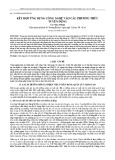
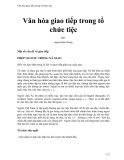
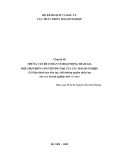
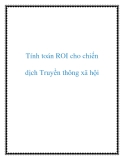
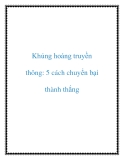


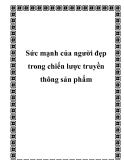
![6 kỹ năng truyền thông xã hội cần biết [mới nhất]](https://cdn.tailieu.vn/images/document/thumbnail/2013/20130604/mountain123123/135x160/1489780_158.jpg)
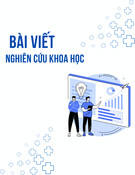
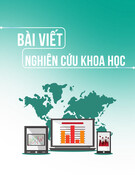
![Đề thi kết thúc học phần môn Truyền thông trong kinh doanh [năm học mới nhất]](https://cdn.tailieu.vn/images/document/thumbnail/2025/20251015/dilysstran/135x160/93281760499390.jpg)
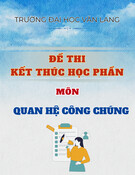
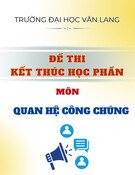
![Bài tập nhóm truyền thông marketing tích hợp [mới nhất]](https://cdn.tailieu.vn/images/document/thumbnail/2025/20250904/hakanami1502@gmail.com/135x160/90671756969236.jpg)
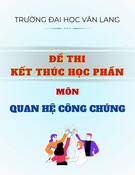
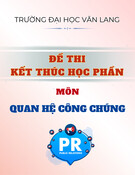
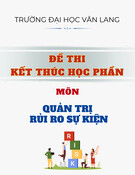


![Định vị doanh nghiệp: Bài thuyết trình [Mới nhất]](https://cdn.tailieu.vn/images/document/thumbnail/2025/20250813/vuthuhuyen1407/135x160/6261755072381.jpg)

